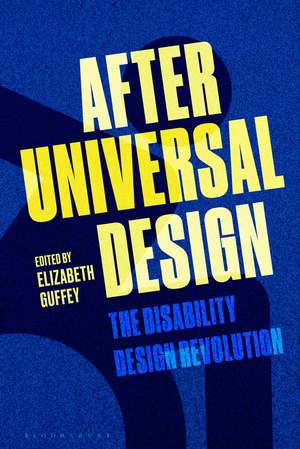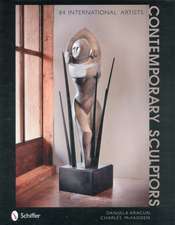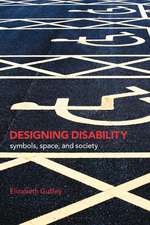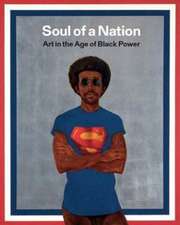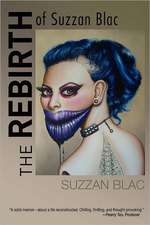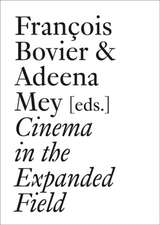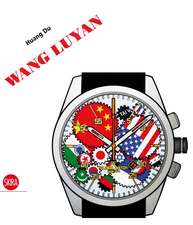After Universal Design: The Disability Design Revolution
Editat de Elizabeth Guffeyen Limba Engleză Paperback – 14 iun 2023
| Toate formatele și edițiile | Preț | Express |
|---|---|---|
| Paperback (1) | 150.78 lei 3-5 săpt. | +23.72 lei 4-10 zile |
| Bloomsbury Publishing – 14 iun 2023 | 150.78 lei 3-5 săpt. | +23.72 lei 4-10 zile |
| Hardback (1) | 410.12 lei 3-5 săpt. | +46.50 lei 4-10 zile |
| Bloomsbury Publishing – 14 iun 2023 | 410.12 lei 3-5 săpt. | +46.50 lei 4-10 zile |
Preț: 150.78 lei
Nou
Puncte Express: 226
Preț estimativ în valută:
28.86€ • 31.36$ • 24.26£
28.86€ • 31.36$ • 24.26£
Carte disponibilă
Livrare economică 31 martie-14 aprilie
Livrare express 14-20 martie pentru 33.71 lei
Preluare comenzi: 021 569.72.76
Specificații
ISBN-13: 9781350241503
ISBN-10: 1350241504
Pagini: 240
Ilustrații: 23 bw illus
Dimensiuni: 156 x 234 x 15 mm
Greutate: 0.58 kg
Editura: Bloomsbury Publishing
Colecția Bloomsbury Visual Arts
Locul publicării:London, United Kingdom
ISBN-10: 1350241504
Pagini: 240
Ilustrații: 23 bw illus
Dimensiuni: 156 x 234 x 15 mm
Greutate: 0.58 kg
Editura: Bloomsbury Publishing
Colecția Bloomsbury Visual Arts
Locul publicării:London, United Kingdom
Caracteristici
Elizabeth Guffey is a leading design historian, author of Designing Disability (2017) and editor of Making Disability Modern (2020), both Bloomsbury books.
Notă biografică
Elizabeth Guffey is Professor of Art and Design History and directs the MA in Modern and Contemporary Art, Criticism and Theory at the State University of New York, Purchase College, USA. She is co-editor of Making Disability Modern (Bloomsbury, 2020) and author of Designing Disability (Bloomsbury, 2018), Posters: A Global History (2015) and Retro: The Culture of Revival (2013). She is Founding Editor of Design and Culture journal and has also published essays in a number of popular publications, including The New York Times and The Nation.
Cuprins
List of FiguresAcknowledgmentsGlossary of TermsIntroduction: A Universal Conundrum, Elizabeth Guffey (SUNY, Purchase College, USA)Section One: AgencySection IntroductionKey Points1. Four Commitments of Crip Technoscience, Kelly Fritsch (Carleton University, Canada) and Aimi Hamraie (Vanderbilt University, USA)2. Fixing Meets Expressing: Design by Designers with Disability Experience, Natalia Pérez Liebergesell, Peter-Willem Vermeersch, and Ann Heylighen (KU Leuven, Belgium) 3. Case Study: Brett's Leather Case, Jaipreet Virdi (University of Delaware, USA)4. Case Study: Zebreda Makes It Work! and the "Key" to Innovation, Elizabeth Guffey (SUNY, Purchase College, USA)5. Case Study: Privileging Agency: A Conversation with Design and Disability Advocate Jessica Ryan-Ndegwa, Alison Kurdock Adams (SUNY, Purchase College, USA)6. Case Study: Rehabilitation Technology at the Self-Help Shop Then and Now, Bess Williamson (SAIC, USA)7. Case Study: Beyond the Bespoke: Agency and The Hands of X, Andrew Cook and Graham Pullin (University of Dundee, UK)8. Case Study: Re-imagining Access and Its Pedagogies, Maggie Hendrie, Joshua Halstead, Robert Dirig, Elise Co, and Todd Masilko (ArtCenter College of Design, USA)Section Two: EquitySection IntroductionKey Points9. Equations for Reducing Disability Stigma through Design Equity, Josh Halstead (ArtCenter College of Design, USA)10. Making Equity: How the Disability Community Met the Maker Movement, Émeline Brulé (University of Sussex, UK)11. Case Study: Shaping Inclusive and Equitable Makerspaces, Katherine M. Steele (University of Washington, USA)12. Case Study: A Study of Skilled Craftwork among Blind Fiber Artists, Maitraye Das and Katya Borgos-Rodriguez (Northwestern University, USA), and Anne Marie Piper (University of California, USA)13. Case Study: Towards Sensory Equity: A More Inclusive Museum Space Designed from Disability Experience, Peter-Willem Vermeersch and Ann Heylighen (KU Leuven, Belgium) 14. Case Study: The Politics of Friction: Designing a Sex Toy for Every Body, David Serlin (UC San Diego, USA)15. Case Study: The Face-Based Pain Scale: A Tool for Whom? Gabi Schaffzin (York University, Canada)16. Case Study: Next Practice: Towards Equalities Design, Natasha Trotman (RCA, UK)Section Three: SpeculationSection IntroductionKey Points17. Speculative Making, Sara Hendren (Olin College of Engineering, USA)18. Speculating on Upstanding Norms, Ashley Shew (Virginia Tech, USA)19. Case Study: M Eifler's Prosthetic Memory as Speculative Archive, Lindsey D. Felt (Stanford University, USA)20. Case Study: The Way Ahead, Caroline Cardus (Independent Artist, UK)21. Case Study: Customizing Reading: Harvey Lauer's "Reading Machine of the Future", Mara Mills (New York University, USA) 22. Case Study: "Captioning on Captioning" with Shannon Finnegan, Louise Hickman (University of Cambridge, UK)23. Case Study: A Squishy House, Emily Watlington (Art in America, USA)24. Case Study: Black Disabled Joy as an Act of Resistance, Jen White-Johnson (Bowie State University, USA)List of ContributorsIndex
Recenzii
The book offers a recentering of disability activism within the emerging discourses and new technologies of makerspace cultures
